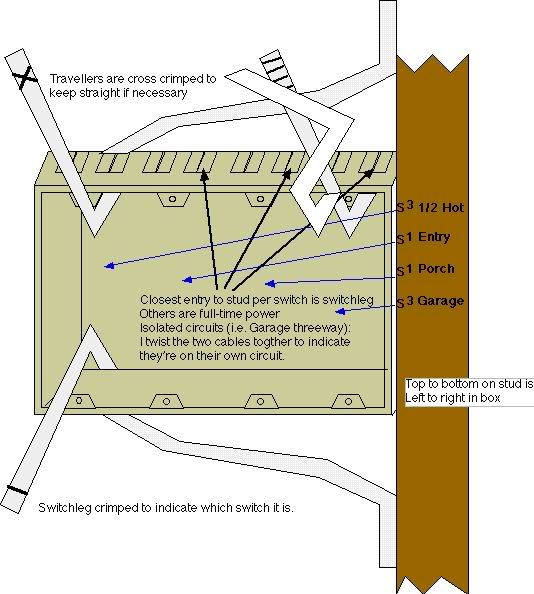Re: Residential- Ways to maximize profit through procedure
Peter,
I picked up notching from 2 different shops in California originally back in the early 70's. One production shop wailed with lineman 9's indenting as we pulled any switch legs, travelers, and home runs. There was no stopping while cutting the cable runs at their terminating points.
Just a heavy hand at indenting the cable end would leave a visible notch code on the outer sheath. When stripping away the insulation jacket still has the same notch so there is no question to the circuit identity and no extra re-ident time needed.
Even after stripping out wires on rough-in makeup, the original indent additionally had penetrated to also notch the conductor. We would have rough-in races in identical apartment dwellings for six-packs later. We kept track of how much time it took for improved marking methods.
We parallel pigtailed prior to stowing so when the rockers & painters finished, the circuits were intact on power-up and the conductor notches were a piece of cake to follow.
George,
The system of panelboard run idents were notched in an easy sequence. For 12-2 or 12-3 the HR cables were notched | for SA1, || for SA2, ||| for Refer, ||| | for micro, ||| || for disp, V for GFCI-1, V| for -2, cw-no notch, etc.
The panel second level marking was for all 14-2 HR cabling used running to general & bedroom L+R circuits. /for L+R ckt-1, // for L+R ckt-2, no notch for FURN motor, etc. A straight | for a Switch leg & || for trav's as we pulled and cut. The romex was loaded in the switch boxes in an order from left to right.
A front door 3 gg would be automatically left top box entry for outside light sw leg, center interior foyer, and right box entry for hall or adjacent living room. Switch leg notches could not be confused regardless of being sp or 3way.
Occasionally I'll help do a home and I've improvised for AFCI idents using |\| as the secret handshake.

Incidentally, I don't see as well as I once could, but I can still wire a switch leg in the dark..just feeling the notches.

rbj, Seattle
I don't dare give a shameless plug, but the complete data is well documented in a book on NM WIRING. (Forgive me BOB.)


